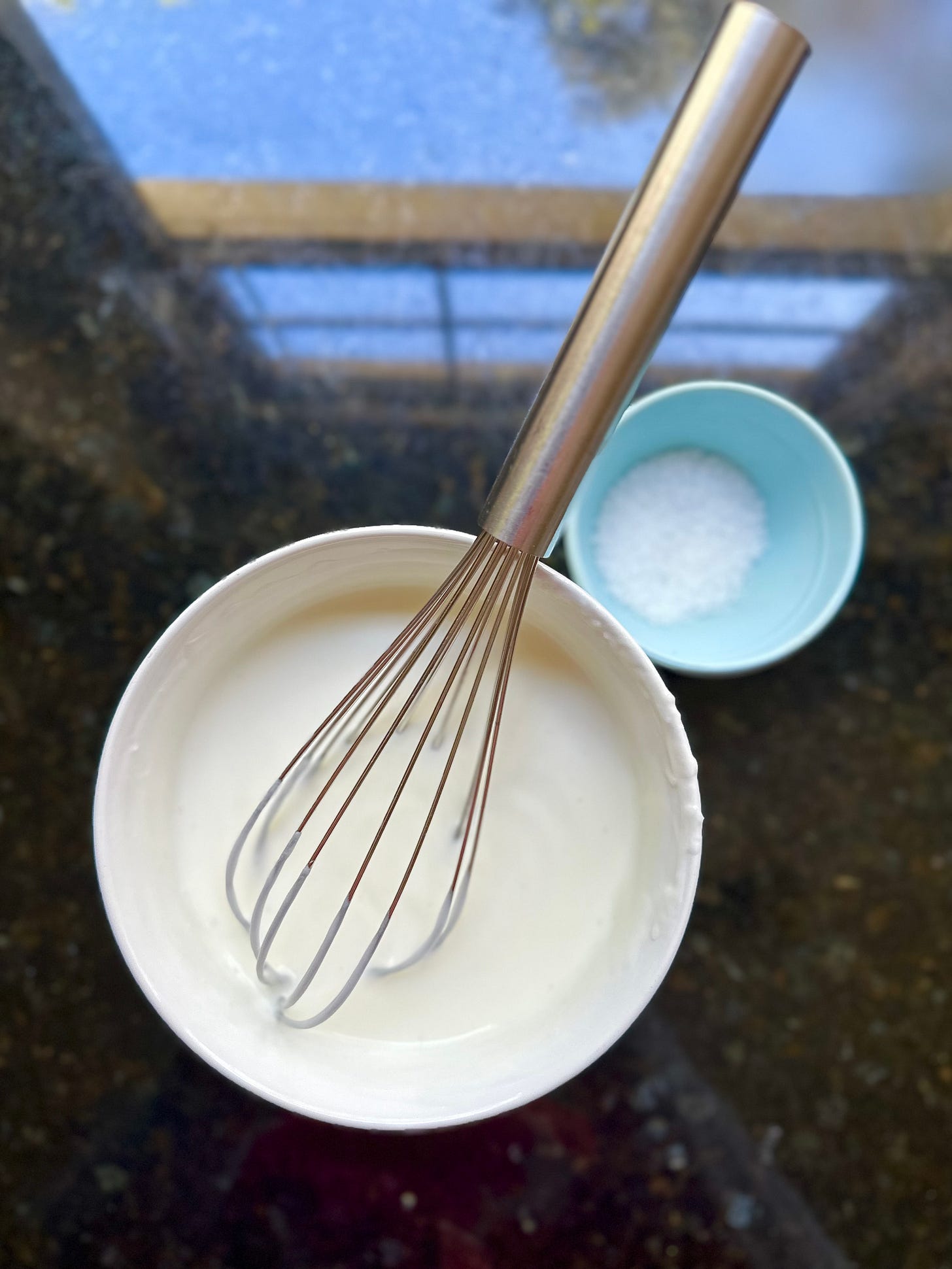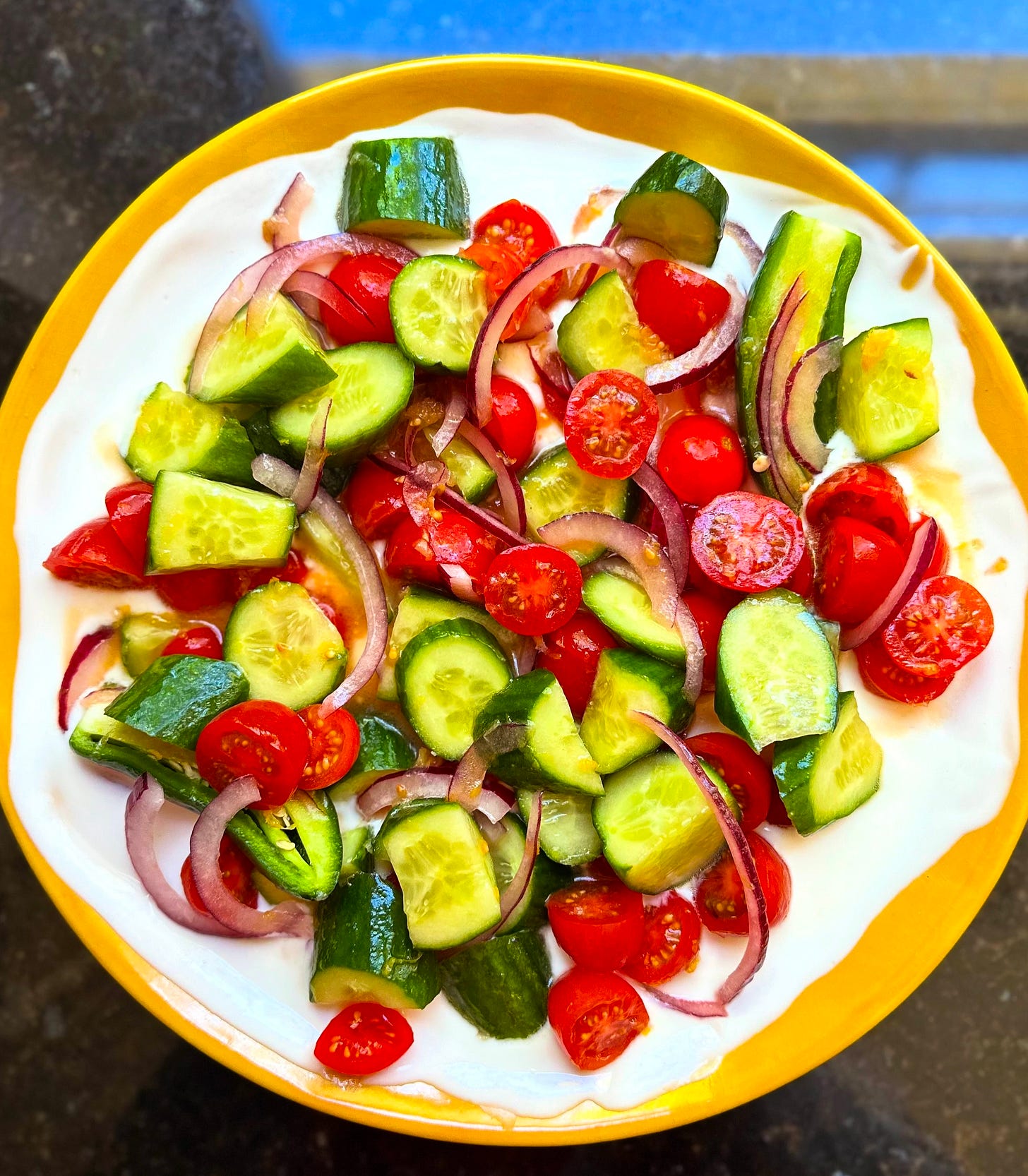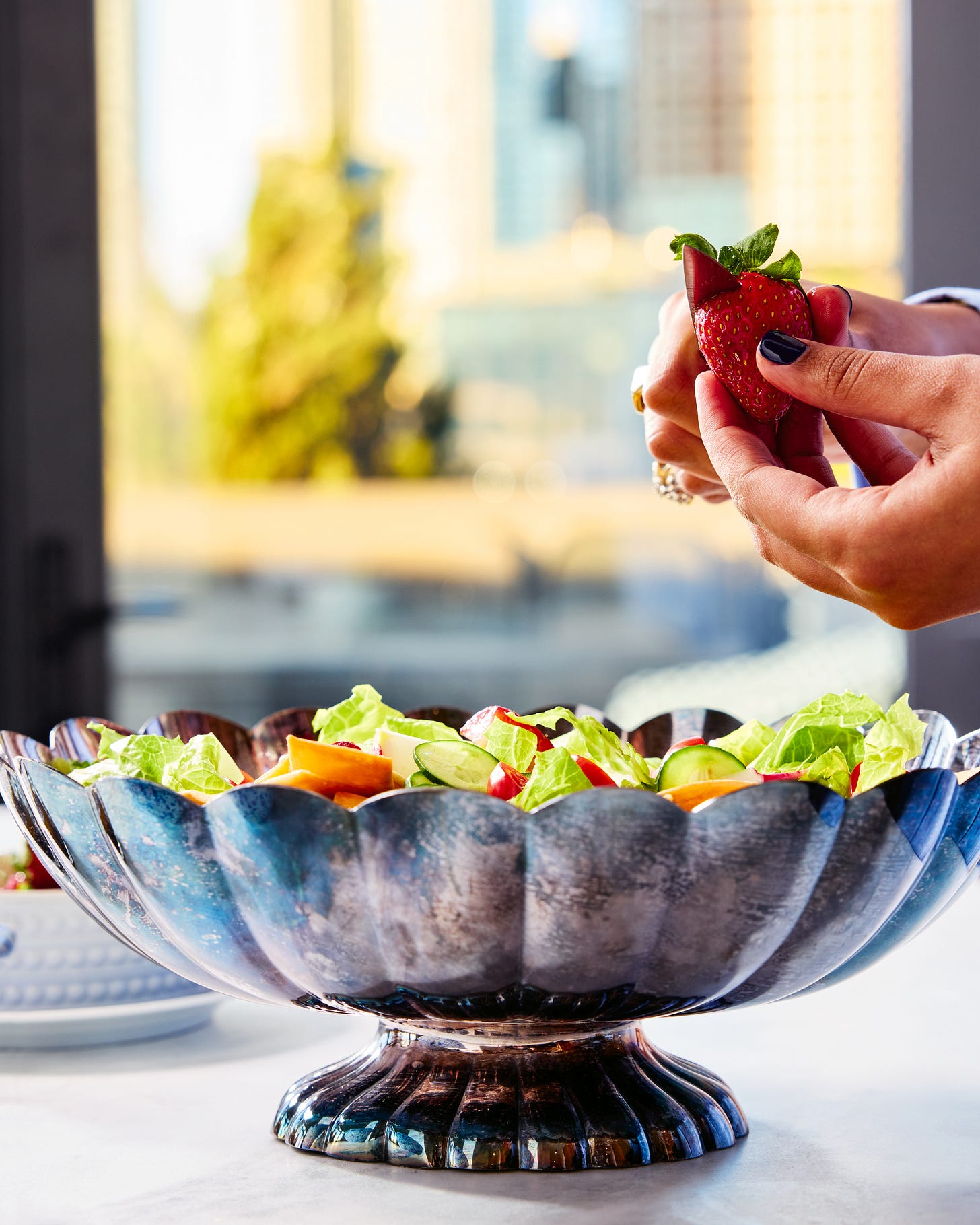Simple But Absolutely Splendid Salads
From a sparkly, wonderful new cookbook that got me back into the kitchen. Also: What I Did on My "Vacation."

IF I HAD TO WRITE A thousand-word essay about what I did on my recent extended break, every single word would be “worry.” Because—despite my plans to write a book proposal and continue work on a novel and another little secret project—worry is what I did during many of my waking hours and sometimes in my dreams. (Was that a dream or was I really worrying? Both!)
And after I worried a thousand times, I started over.
So I got a lot of worrying done. But one significant activity that punctuated all this fretting (and something I haven’t done much since I was in my twenties) was surfing—surfing on a wave of panic attacks.
Have you ever had a panic attack? Before you answer, I’d like to clarify that I am not asking if you’ve ever experienced panic about, say, whether or not you left the iron on back at the house or the fact that you forgot to lay out an outfit for school and now you’ll be late for the bus. This is something different.
A true panic attack is one of those things that sticks with you forever, much like your first kiss—except you’re kissing a guy in a hooded cloak with only darkness for a face.
Or, at least, that’s the way it feels to me. You become convinced that even though you have no known illness and have not hit your head or consumed deadly poison, you’re about to die or disappear from the earth. It can also feel as though your very essence has left your body but is floating directly above you, like a balloon on a string.
I had these episodes frequently in my 20s, but then they suddenly disappeared (until now), after I moved to NYC, which I had been afraid would make them worse. There seems to be very little consistent logic to their arrival or disappearance.
And there are many methods for extinguishing these psychic spasms, some of which, I can tell you from experience, can lead down a road that’s even scarier than Panic Attack Avenue.

But before I discovered various chemical “cures,” prescribed and otherwise, the one thing that slowly but surely brought me back down to earth, calmed me, and convinced me that that my head was not going to fall off and roll down the street, was the sight of full bookshelves
In college, if I was anywhere near the giant university library I’d get myself there and sit in the stacks to browse until I was out of danger, and usually for hours afterward.
DID YOU KNOW? It takes two kinds of lettuce (🥬 + $$) to keep the Department of Salad alive. The best way to support us, if you don’t already: Press the green button (and get full access to all the salad in our enormous archive).
In my ensuing panic-plagued years, I’d sit down in front of my own shelves, opening one book after the other, reacquainting myself with the person who’d read all of these books. She was the same person who’d acquired but never read plenty of them, but it didn’t matter. They all soothed me and reminded me of who I was. To paraphrase one book that I (and most recent English Lit grads back then) was entranced by in my twenties: the pleasure of the text was my balm.
Now, decades later, during my alleged break, my books came to my rescue with the same restorative magic. And anyone who reads this newsletter knows that I am not exactly a linear thinker, which is reflected in how I skipped around my shelves.
Over the last month, I finished almost every wonderful book by Elizabeth Strout—who has the remarkable power of making you feel, even when terrible things are happening, that we’re all going to be okay. I ventured back to the youthful reading of my early post-panic era, to the thrillingly perfect short stories of Cheever (I used to carry the omnibus edition of his stories in my purse, like a bottle of valium), William Trevor, and Chekov, which I supplemented with essays (by Susan Sontag and Joan Didion) and other nonfiction (such as Alfred Kazin’s A Walker in the City and E. M. W. Tillyard’s strangely soothing The Elizabethan World Picture) that has gone in and out fashion since I first encountered it.
But one thing I could never have known back then: Cookbooks (and any kind of book on food, really) would eventually have the same power over me. Today, my digital collection of food-related books has probably surpassed my physical collection, which covers not just my shelves but every surface in my house. They make me happy in a way my books in the ether simply cannot.
So over the last several weeks, in addition to worrying, I carried stacks of cookbooks and food books, both old and new, up the stairs each night to bed, where I had a lovely, cozy time thumbing through their pages, in no rush at all, getting to know them again in a way I’ve missed during the last 4½ years that I’ve been writing this newsletter.
I am one of those readers whose habits are a bit like the ball in a pinball machine. I spent quality time with a variety of food books including Jacques Pepin’s Essential Pepin; The Dinah Shore Cookbook; Harold McGee’s On Food and Cooking: The Science and Lore of the Kitchen; the 1976 edition of The Nashville Cookbook: Specialties of the Cumberland Region, by the Nashville Area Home Economics Association; The Contemporary African Kitchen, by Alexander Smalls; the late great Molly O’Neill’s One Big Table: A Portrait of American Cooking; George Lang’s The Cuisine of Hungary; and A Book of Hors d’Oeuvre by Lucy G. Allen. I finally got around to starting Bee Wilson’s wonderful The Secret of Cooking. And I am now reading OG food blogger Adam Roberts’s completely delightful first book of fiction, Food Person, which doesn’t come out until May.
I should point out that as a minor “food person” myself, I occasionally receive early copies of new food books (it’s quite customary). Some I am neutral on, so you won’t see them here. And others, occasionally, make me want to go straight to my kitchen to start making dishes from their pages.
One upcoming book I received this month compelled me to do just that—despite promising myself I’d do very little cooking during my month of “rest.” It’s sparkly and wonderful, and it’s coming out next week: Third Culture Cooking: Classic Recipes for a New Generation, by Zaynab Issa, who has worked as a food editor at Bon Appetit and is a contributor at New York Times Cooking (as well as King Arthur Baking, The Kitchn, and Food52). Her recipes reflect growing up in suburban New Jersey as a first-generation, Ina Garten-loving American with East African and South Asian roots. (Her mother and father were both born in Tanzania.)
It’s a beautiful book, and it’s also a very modern book—by which I think I mean that the recipes are quite serious while the recipe creator herself exhibits a light touch, a nimble sensibility, and a sense of humor. Plus: family roots! (Some of the recipes were inspired by and named after relatives). It’s just a great combination.
So you’ll find such dishes as Arrogant Tomato Toast, French Onion Ramen, TGIF Artichoke Dip, and An Iconic Chicken Pot Pie alongside Shenaz’s Chicken Haleem, Riffat’s Kuku Paka, Rumina’s Kebabs and Coconut Chutney, and Rishma’s Pilau. I couldn’t put this book down, and I do want to cook practically every recipe in it.
For our purposes—as salad people—the book still comes through: Halal Cart Salad; Herby, Garlicky Pasta Salad; a Shawarma Salad Wrap; Grape and Fennel Salad! Plus the two salads I have for you today: Lemony Cucumber Salad with Salted Yogurt and Fruity Fattoush.
I’m mad about both, partly because I love dishes with subtle surprises. Both of these fit the bill. Mint in salads always feels like the best kind of eye-opener to me, and although it is typical in fattoush, strawberries definitely are not—but that’s what you’ll find in Issa’s Fruity Fattoush. (If strawberries are not in season where you live, note that Issa includes alternative ingredients for all her recipes.) And her Lemony Cucumber Salad with Salted Yogurt offers gifts many of your favorite fast salads probably don’t, by which I mean a dazzling combination of richness and lightness and depth of flavor. It’s crunchy, sweet, salty, creamy. Salted yogurt forever, man.
🍅 🥕 🥬 🌿
ONE ASK, BEFORE YOU HIT THE RECIPE?
Would you mind hitting the ❤️ button at the top left or bottom left of this newsletter if you enjoy being here? It means more to us than you might imagine and puts a little more git in our gittyup. XO—Emily
🍅 🥕 🥬 🌿
*RECIPE: Lemony Cucumber Salad with Salted Yogurt, from Third Culture Cooking: Classic Recipes for a New Generation, by Zaynab Issa
Serves 2 to 4
ZAYNAB ISSA’S RECIPE NOTE: A zesty combination of two necessary accompaniments to most of the food I grew up eating: kachumber and salted yogurt. Kachumber is an acidic side salad, usually made with vinegar or lemon juice, onions, tomatoes, sometimes cucumbers, and always chilis. And salted yogurt is, well, salted yogurt. Here they’re served together as a crunchy, creamy, cool salad that’s as good on its own as it is with biryani or roast chicken.
1 cup plain whole-milk yogurt
1¾ teaspoons Diamond Crystal kosher salt, divided
1 lemon*, zested and juiced (about ¼ cup juice)
1 green bird’s-eye chili*, halved lengthwise
2 tablespoons extra virgin olive oil
4 mini cucumbers* (12 ounces), sliced into 1½-inch pieces
1 cup cherry tomatoes, halved or quartered depending on the size
½ cup sliced red onion
In a small bowl, whisk the yogurt with 1 teaspoon of the salt. Spread the mixture over the bottom of a shallow platter.
In a medium bowl, combine the lemon zest and juice, chili, olive oil, and the remaining ¾ teaspoon salt. Add the cucumbers, tomatoes, and onion to the dressing and toss to coat. Spoon over the yogurt mixture and serve immediately.
*INSTEAD OF . . .
Lemon, use lime
Bird’s-eye chili, use jalapeño or lots of black pepper
Cucumbers, use another crunchy raw or roasted veg
*RECIPE: Fruity Fattoush, from Third Culture Cooking: Classic Recipes for a New Generation, by Zaynab Issa
Serves 2 to 4
ZAYNAB ISSA’S RECIPE NOTE: A Levantine classic, fattoush is a truly craveable salad. It’s refreshing and tangy thanks to a combination of three tart elements: pomegranate molasses, sumac, and lemon juice. It’s traditionally made with freshly fried pita scraps, but I use packaged pita chips to keep things fast and easy. Another atypical addition: strawberries (or any ripe in-season fruit I have on hand) for a sweet contrast to the tangy dressing. It’s very riff-friendly, so use this ingredient list as a guideline and substitute whatever crunchy veg, herbs, and fruit you’re trying to use up. And, if you’re not a fruit-in-salad person, you can skip the strawberries and be left with a fairly traditional fattoush.
FOR THE DRESSING
¼ cup fresh lemon juice, from 1 to 2 lemons
2 tablespoons extra virgin olive oil, plus more as needed
2 tablespoons pomegranate molasses*
1 garlic clove, finely grated
1 teaspoon sumac*
1 teaspoon Diamond Crystal kosher salt
Freshly cracked black pepper
FOR ASSEMBLY
2 tablespoons roughly torn fresh mint leaves*
2 scallions, thinly sliced
2 large red radishes, chopped
½ cup heirloom or cherry tomatoes, halved or quartered
1 mini Persian cucumber, halved lengthwise and sliced into ¼-inch-thick half moons
1 large head romaine lettuce (10 to 12 ounces),* chopped
1 cup strawberries,* hulled and chopped
1 cup salted pita chips
To make the dressing: Combine the lemon juice, olive oil, pomegranate molasses, garlic, sumac, salt, and a few turns of the peppermill in a large bowl. Taste and adjust to your preference. If it’s punchier than you prefer, add an extra tablespoon or so of olive oil.
To assemble: Tilt the bowl to coat the sides with the dressing. Add the mint, scallions, radishes, tomatoes, cucumber, lettuce, strawberries, and pita chips to the bowl. Toss to coat and serve immediately.
*INSTEAD OF . . .
Pomegranate molasses, use good-quality, thick balsamic vinegar
Sumac, use the zest of 1 lemon
Mint, use any tender-stem herbs, like basil, cilantro, or parsley
Romaine lettuce, use other crisp greens
Strawberries, use any other ripe, in-season fruit, like pomegranate, papaya, mango, grapes, peaches, or persimmon
🥬 🥬🥬 🥬🥬
🥬 🥬🥬 🥬That’s It! We’re done here! We’ll see you soon with a recipe for authentic Greek avgolemono soup. I’m kidding—it’s going to be salad.
🥬🥬🥬 ONE MORE THING: Please remember that while you may receive The Department of Salad as an e-mail, all issues of the newsletter—along with any corrections, the archive, and our Fancy New Recipe Index—are always available at the Department of Salad website. (You can always search “The Department of Salad” or go directly to emilyrnunn.substack.com.) All the recipes from all the newsletters will be there for you. To search the Index, simply use the search function (command F) that produces a search bar in the upper-right-hand corner of the page.
🥬 🥬ALSO, I’M WONDERING: Do you follow me on Instagram? My feed is not a consistent array of uniformly styled photos of perfect food, which I know is what I’m supposed to offer. But I get too bored. So it includes videos of giant pandas loudly eating carrots and personal crap representative of my bad personality. I’d love to have you. Go here: Emily’s Instagram
🥬 IN THE MEANTIME: If you feel like sharing the Department of Salad with friends or family who deserve it, please do so with the buttons below. It would mean the world to us! Thanks for being a subscriber. ❤️ 💕 💝














Dear Emily, I too read cookbooks for comfort and personal enrichment- I feel more like a person when I enter the consciousness of the cookbook author. I even enjoy the blurbs of Sam Sifton and the other food writers at the Times and the comments from fellow cooks as well.
Please do write a cook book I can hug at night. Your columns are so humane. I’m sure a book you wrote would be too. Lisa
I just looked up the definition of humane
Showing compassion or benevolence but also having a civilizing effect.
I love that you love the Dinah Shore Cookbook! Did you know that she also wrote Someone’s in the Kitchen with Dinah and The Dinah Shore American Kitchen? Those books kept me sane when my husband was undergoing cancer treatment when he was 25. I would sit in a recliner with my cat Muffin, eating Cheetoes and reading. Pure comfort.